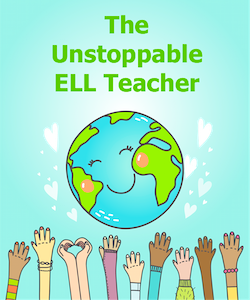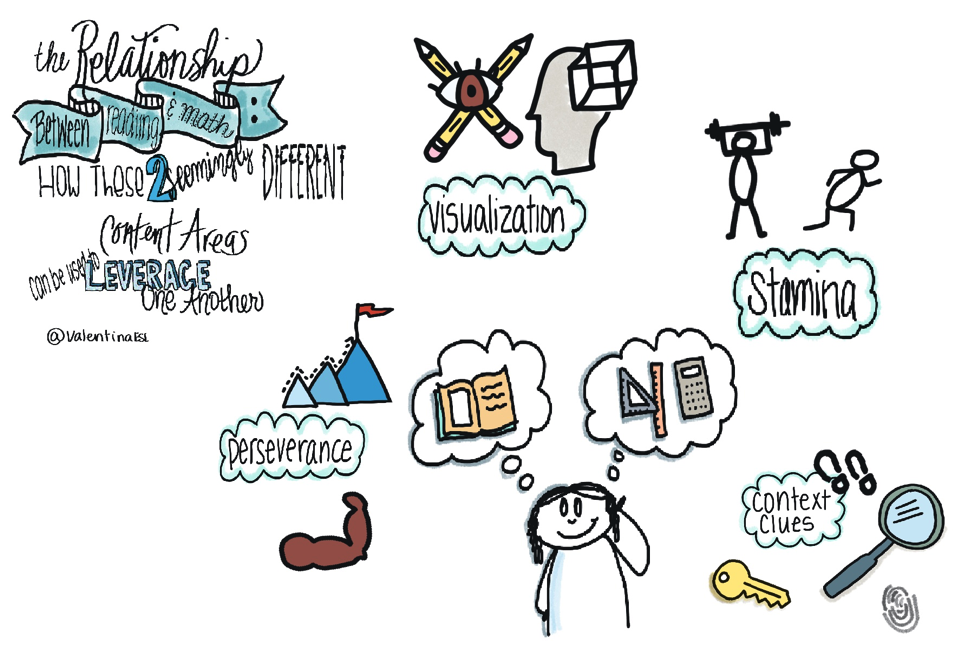How Reading and Math Leverage Each Other
A MiddleWeb Blog
 Let me begin by admitting that when it comes to reading and math, I lean more towards the reading side of education. I’d say typically that as educators we take a side.
Let me begin by admitting that when it comes to reading and math, I lean more towards the reading side of education. I’d say typically that as educators we take a side.
The good news is that no matter which side you’re on, by identifying what effective readers and mathematicians do, we can use strengths from one content area to capitalize on the other.
I had this particular aha moment in July 2017 after attending a session titled How to Connect Math and Literacy: Get Students Reading, Writing, and Speaking in Math Class by Alex Kajitani, California Teacher of the Year.
I really connected with many things he said, especially “Now, I don’t claim to be an expert in the area of math, but I know a thing or two about students, reading, writing, and language development.”
What happened then was that I bridged my knowledge of reading instruction to my new learning about math instruction. This is actually what we want to do for students everyday! Take something they know and add to it. Build on their knowledge. Transfer our skills from here to there. BOOM!
Creating math<!!!>reading synergy
It’s important for us to recognize the relationship between reading and math and how these two seemingly different content areas can be used to leverage one another when we apply our skill sets and those of our students. Here’s what that looks like.
Effective readers and mathematicians exemplify some similar characteristics.
- Both understand how to create mental images. Effective readers visualize while reading a book or passage while effective math students create mental images of shapes and numbers whether they be dimensions, lengths or amounts, etc.
- Both use context to understand the unknown. While reading text, effective readers are able to make meaning of words they are unfamiliar with by using context clues. Effective math students use mathematical symbols and formulas as clues that guide them in how to proceed in order to solve the problem.
- Both effective readers and effective math students have stamina and perseverance when faced with an academic task. They are able to stick with their reading or math until they complete the job.
Why is knowing this important?
Recognizing that reading and math have connections is valuable to us as teachers. For example, if a student was progressing well in reading but struggling in math I might be able to capitalize on the student’s reading abilities to build the math.
T: Lauren, look at how you have grown as a reader. Your reading level has advanced and you have read several books in many different genres this grading period. I’m proud of your hard work. What do you do to make sure that you continue to grow as a reader?
S: I read a lot. I take a book with me everywhere I go and I finish the books I start. When I finish one book, I pick a new book.
T: That’s awesome. Sticking with your book shows focus and perseverance. You can use that same quality in math. When you start a math problem, don’t give up. Just like with the books you read, keep with it until the end.
Now imagine the reverse situation – a student is strong in math but needs more scaffolding and support in reading. Begin by highlighting their math strengths and help them imagine the bridge from math to reading.
Showing students how to use their strengths from one content area in another content area is powerful for them. They begin to realize that learning is a process and it empowers them.
Math is about more than numbers
Math is not just about numbers and calculations. If we want our students to have a deep understanding of math, Kajitani says they need to think about it, talk about it, read and write about it, and share it. I couldn’t agree more! We need our kids to SWIRL (Speak, Write, Interact, Read, and Listen) in all content areas including math.
Finally, it’s important that we explicitly teach the academic vocabulary that is specific to math and to reading. There are many words that have multiple meanings. These can be confusing for English learners. And they can stump all students, not just English Learners.
Think about words such as plus, sum, mean, order, problem, even, odd, right, etc. The word sum sounds the same as some. Teaching the difference between the two similar-sounding words and how sum is used in math is important for ELLs. Or the word mean…it can be confusing for a student learning English when they think the word mean means not nice, but then they hear it in math and that meaning doesn’t make sense.
Please don’t get me wrong. I’m not saying that math and reading are the same thing. I’m merely saying there are similarities. And it’s helpful to recognize them as we work with students who may feel they are stronger in one than in the other. Strengths-based learning. That’s what we’re all about, right?



































What a great article, Valentina. I’ve never thought about how good readers of books can apply their skills to math. Visualizing is a big one! I usually just teach students to close-read a word problem. You go to the next level with context clues and have stamina.
Thanks again for your insight.
Thank you for reading and commenting, Tan. I’m always learning from colleagues like you! Getting myself to transfer was the first step to helping students to do the same.